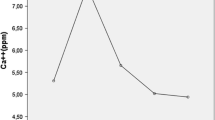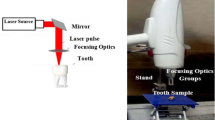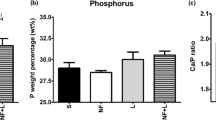Abstract
Objectives
The morphology and chemical composition of enamel submitted to different sterilization methods was studied.
Methods
X-ray photoelectron spectroscopy (XPS), field emission gun scanning electron microscopy (FEG-SEM), and energy-dispersive X-ray spectroscopy (EDS) were performed to evaluate 50 bovine enamel specimens sterilized using four methods: microwaving (MI), gamma irradiation (GI), ethylene oxide (EO), and steam autoclave (SA). Non-sterilized specimens were used as control.
Results
XPS indicated that the concentration of P (phosphorus), CO3 (carbonate), and CO3/P was not changed in all groups. GI produced no significant change on elemental composition. SA produced the major decrease in calcium (Ca), Ca/P ratio, and increase in N (nitrogen). MI was found to decrease Ca, Ca/P ratio and O (oxygen), and increase in C (carbon) and N. EO produced decrease in Ca and O with increased C concentration. FEG-SEM revealed surface and in-depth morphological changes on SA specimens. Minor surface alterations were observed for EO and for MI groups, and no alteration was observed on GI group. EDS indicated no difference on elemental composition of enamel bulk among groups.
Conclusions
SA produced mineral loss and morphological alterations on surface and in depth. MI and EO sterilization caused mineral loss showing only slight alteration on enamel surface. GI sterilization preserves the morphological characteristics of enamel. The sterilization methods could be classified from lower to high damage as GI < MI < EO < SA.
Clinical relevance
This is a comprehensive comparative study where different methods for enamel sterilization were investigated in terms of chemical changes. The results presented here may help researchers to choose the most appropriate method for their research setting and purpose.




Similar content being viewed by others
References
Shellis RP, Ganss C, Ren Y, Zero DT, Lussi A (2011) Methodology and models in erosion research: discussion and conclusions. Caries Res 45:69–77
Mellberg JR (1992) Hard-tissue substrates for evaluation of cariogenic and anti- cariogenic activity in situ. J Dent Res 71:913–919
Kohn WG, Collins AS, Cleveland JL, Harte JA, Eklund KJ, Malvitz DM (2003) (2003). Centers of disease control and prevention (CDC). Guidelines for infection control in dental health-care settings. MMWR Recomm Rep 52:1–76
Rutala WA, Weber DJ (2008) Healthcare Infection Control Practices Advisory Committee (HICPAC). Guideline for Disinfection and Sterilization in Healthcare Facilities. MMWR 1–158
Chandler NP (1990) Preparation of dental enamel for use in intraoral cariogenicity experiments. J Dent 18:54–58
Amaechi BT, Higham SM, Edgar WM (1998) Efficacy of sterilization methods and their effect on enamel demineralization. Caries Res 32:441–446
Amaechi BT, Higham SM, Edgar WM (1999a) Effect of sterilization methods on the structural integrity of artificial enamel caries for intra-oral cariogenicity tests. J Dent 27:313–316
Amaechi BT, Higham SM, Edgar WM (1999b) The use of gamma irradiation for the sterilization of enamel for intra-oral cariogenicity tests. J Oral Rehabil 26:809–813
White RR, Hays GL (1995) Failure of ethylene oxide to sterilize extracted human teeth. Dent Mater 11:231–233
White JM, Goodis HE, Marshall SJ, Marshall GW (1994) Sterilization of teeth by gamma radiation. J Dent Res 73:1560–1567
Clasen AB, Ogaard B (1999) Experimental intra-oral caries models in fluoride research. Acta Odontol Scand 57:334–341
Kumar M, Sequeira PS, Peter S, Bhat GK (2005) Sterilisation of extracted human teeth for educational use. Indian J Med Microbiol 23:256–258
Lolayekar NV, Bhat VS, Bhat SS (2007) Disinfection methods of extracted human teeth. J Oral Health Community Dent 1:27–29
Viana PS, Machado AL, Giampaolo ET, Pavarina AC, Vergani CE (2010) Disinfection of bovine enamel by microwave irradiation: effect on the surface microhardness and demineralization/remineralization processes. Caries Res 44:349–357
Robinson C, Shore RC, Brookes SJ, Strafford S, Wood SR, Kirkham J (2000) The chemistry of enamel caries. Crit Rev Oral Biol Med 11:481–495
Brunner E, Langer F (2000) Nonparametric analysis of ordered categorical data in designs with longitudinal observations and small sample sizes. Biom J 42:663–675
Shaffer SE, Barkmeier WW, Gwinnett AJ (1985) Effect of disinfection/sterilization on in vitro enamel bonding. J Dent Educ 49:658–659
Dominici JT, Eleazer PD, Clark SJ, Staat RH, Scheetz JP (2001) Disinfection/sterilization of extracted teeth for dental student use. J Dent Educ 65:1278–1280
Rodrigues LK, Cury JA, Santos MN (2004) The effect of gamma radiation on enamel hardness and its resistance to demineralization in vitro. J Oral Sci 46:215–220
Weatherell JA, Robinson C, Hallsworth AS (1974) Variations in the chemical composition of human enamel. J Dent Res 53:180–192
Mine A, Yoshida Y, Suzuki K, Nakayama Y, Yatani H, Kuboki T (2006) Spectroscopy characterization of enamel surfaces irradiated with Er:YAG laser. Dent Mater J 25:214–218
Ruse ND, Smith DC, Torneck CD, Titley KC (1990) Preliminary surface analysis of etched, bleached, and normal bovine enamel. J Dent Res 69:1610–1613
Taube F, Ylmén R, Shchukarev A, Nietzsche S, Norén JG (2010) Morphological and chemical characterization of tooth enamel exposed to alkaline agents. J Dent 38:72–81
Lou L, Nelson AE, Heo G, Major PW (2008) Surface chemical composition of human maxillary first premolar as assessed by X-ray photoelectron spectroscopy (XPS). Appl Surf Sci 254:6706–6709
Es-Souni M, Fischer-Brandies H, Zaporojshenko V, Es-Souni M (2002) On the interaction of polyacrylic acid as a conditioning agent with bovine enamel. Biomaterials 23:2871–2878
Lu HB, Campbell CT, Graham DJ (2000) Surface characterization of hydroxyapatite and related calcium phosphates by XPS and TOF-SIMS. Anal Chem 72:2886–2894
Gerth HU, Dammaschke T, Schäfer E, Züchner H (2007) A three-layer structure model of fluoridated enamel containing CaF2, Ca(OH)2 and FAp. Dent Mater 23:1521–1528
Xu C, Reed R, Gorski JP, Wang Y, Walker MP (2012) The distribution of carbonate in enamel and its correlation with structure and mechanical properties. J Mater Sci 47:8035–8043
Robinson C, Wheatherell JA, Halls-Worth AS (1971) Variation in composition of dental enamel within thin ground tooth sections. Caries Res 5:44–47
Cheng L, Li J, Hao Y, Zhou X (2010) Effect of compounds of Galla chinensis on remineralization of enamel surface in vitro. Arch Oral Biol 55:435–440
Nakata K, Nikaido T, Ikeda M, Foxton RM, Tagami J (2009) Relationship between fluorescence loss of QLF and depth of demineralization in an enamel erosion model. Dent Mater J 28:523–529
Naumova EA, Niemann N, Aretz L, Arnold WH (2012) Effects of different amine fluoride concentrations on enamel remineralization. J Dent 40:750–755
De Menezes Oliveira MA, Torres CP, Gomes-Silva JM, Chinelatti MA, De Menezes FC, Palma-Dibb RG, Borsatto MC (2010) Microstructure and mineral composition of dental enamel of permanent and deciduous teeth. Microsc Res Tech 73:572–577
Souza RO, Lombardo GH, Pereira SM, Zamboni SC, Valera MC, Araujo MA, Ozcan M (2010) Analysis of tooth enamel after excessive bleaching: a study using scanning electron microscopy and energy dispersive X-ray spectroscopy. Int J Prosthodont 23:29–32
Rodríguez-Vilchis LE, Contreras-Bulnes R, Sánchez-Flores I, Samano EC (2010) Acid resistance and structural changes of human dental enamel treated with Er:YAG laser. Photomed Laser Surg 28:207–211
Rodríguez-Vilchis LE, Contreras-Bulnes R, Olea-Mejὶa OF, Sánchez-Flores I, Centeno-Pedraza C (2011) Morphological and structural changes on human dental enamel after Er:YAG laser irradiation: AFM, SEM, and EDS evaluation. Photomed Laser Surg 29:493–500
Mollah MYA, Tsai Y, Hess TR, Cocke DL (1992) FTIR, SEM and EDS investigation of solidification/ stabilization of chromium using Portland cement type V and type IP. J Hazard Mater 30:273–283
Montasser MA, Drummond JL, Roth JR, Al-Turki L, Evans CA (2008) Rebonding of orthodontic brackets. Part II, an XPS and SEM study. Angle Orthod 78:537–544
Wang C, Li Y, Wang X, Zhang L, Tiantang FB (2012) The enamel microstructures of bovine mandibular incisors. Anat Rec (Hoboken) 295:1698–1706
Ana PA, Tabchoury CPM, Cury JA (2012) Effect of Er,Cr:YSGG laser and professional fluoride application on enamel demineralization and on fluoride retention. Caries Res 46:441–451
Parker SPA, Darbar AA, Featherstone JDB, Iaria G, Kesler G, Rechmann P et al (2007) The use of laser energy for therapeutic ablation of intraoral hard tissues. J Laser Dent 15:78–86
Rosaspina S, Salvatorelli G, Anzanel D, Bovolenta R (1994) Effect of microwave radiation on Candida albicans. Microbios 78:55–59
Atmaca S, Akdag Z, Dasdag S, Celik S (1996) Effect of microwaves on survival of some bacterial strains. Acta Microbiol Immunol Hung 43:371–378
Gilbert GI, Gambill VM, Spiner DR, Hoffman RK, Phillips CR (1964) Effect of moisture on ethylene oxide sterilization. Appl Environ Microb 12:496–503
Lussi A (2006) Dental erosion from diagnosis to therapy. Karger, Basel
Korystov YN (1992) Contribution of the direct and indirect effects of ionizing radiation to reproductive cell death. Radiat Res 129:228–234
Acknowledgements
We thank Dr. Peter Hammer for the XPS analysis and technical assistance. We would also like to thank ACECIL, Comércio e Esterilização a Óxido de Etileno and IPEN - Instituto de Pesquisas Energéticas e Nucleares, for their continuous support for sterilization of enamel specimens with ethylene oxide and gamma irradiation, respectively. The authors declare no potential conflicts of interest with respect to the authorship and/or publication of this article.
Author information
Authors and Affiliations
Corresponding author
Ethics declarations
Conflict of interest
Author Viana, PS, declares that he has no conflict of interest. Author Orlandi, MO, declares that he has no conflict of interest. Author Pavarina, AC, declares that he has no conflict of interest. Author Machado, AL, declares that he has no conflict of interest. Author Vergani, CE, declares that he has no conflict of interest.
Funding
The work was supported by the State of São Paulo Research Foundation (FAPESP) within the framework of the project no. 2011/09416-0 and 2011/10358-4. The funders had no role in study design, data collection and analysis, decision to publish, or preparation of the manuscript.
Ethical approval
This article does not contain any studies with human participants or animals performed by any of the authors.
Informed consent
For this type of study, formal consent is not required.
Rights and permissions
About this article
Cite this article
Viana, P.S., Orlandi, M.O., Pavarina, A.C. et al. Chemical composition and morphology study of bovine enamel submitted to different sterilization methods. Clin Oral Invest 22, 733–744 (2018). https://doi.org/10.1007/s00784-017-2148-5
Received:
Accepted:
Published:
Issue Date:
DOI: https://doi.org/10.1007/s00784-017-2148-5




